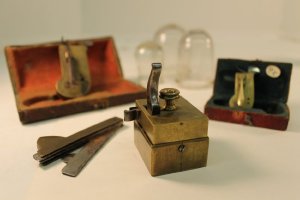Bloodletting is the removal of blood from a patient to cure or prevent illness and disease. It is based on a system of medicine in which blood and other bodily fluids were regarded as humors that must remain in proper balance in order to maintain health. Bloodletting is believed to have been the most common medical practice from antiquity unitl the late 19th century.
Bloodletting was first performed by the Ancient Egyptians around 1000 BCE. Later, the practice spread to the Greeks and Romans. During the time of Hippocrates in the fifth century BC it was a common practice.
Though bloodletting was typically recommended by physicians, it was often carried out by barbers. This practice led to the distinction between physicians and surgeons. The red and whide striped pole of the barbershop is derived from this practice. The red symbolized blood and the white symbolized the bandages.
Bloodletting was used to treat a wide range of deseases, becoming the standard treatment for almost every ailment. Many times the treatment was accompanied by a dose of a strong cathartic, purging the patient of any bad humors.
While bloodletting became less popular in Europe during the 18th century, it remained a popular treatment in America. Benjamin Rush, a strong proponent of bloodletting, and seeing the state of the arteries as the key to disease, recommended levels of bloodletting that were high even for the time. George Washington was another firm believer in the healing powers of bloodletting. In 1799 when Washington came down with a throat infection he asked to be bled. Within a ten hour period approximately 125 ounces of blood was withdrawn, making blood loss the likely cause of his death rather than the throat infection.
The collection at the Edward Hand Medical Heritage Foundation includes a variety of 18th and 19th century bloodletting instruments from fleams, instruments resembling pocket knives, to spring loaded lancets and scarifiers.
